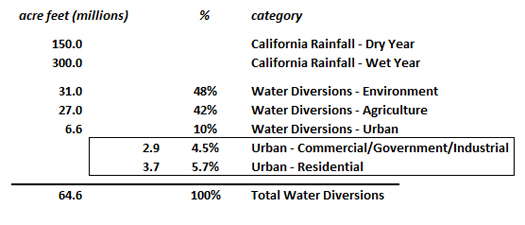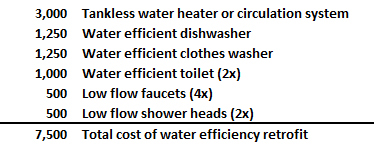Water Rationing Laws Exemplify the Malthusian Mentality of California’s Legislators
As reported in the Sacramento Bee and elsewhere, on May 31st Gov. Jerry Brown “signed a pair of bills Thursday to set permanent overall targets for indoor and outdoor water consumption.”
After pressure from the Association of California Water Agencies and others, the final form of these bills, Assembly Bill 1668 by Assemblywoman Laura Friedman, D-Glendale, and Senate Bill 606 from state Sen. Bob Hertzberg, D-Los Angeles, offers water districts more flexibility in enforcing the new restrictions. But the focus of AB 1668, limiting indoor water use to 50 gallons per resident per day, is a step too far. Way too far.
There’s nothing wrong with conserving water. But urban water consumption in California is already low, and squeezing even more out of Californians will be costly and bothersome without making much difference in the big picture. Here is a table showing California’s overall water consumption by user:
Total Water Supply and Usage in California

As can be seen, in a state where total human water diversions total around 65 million acre feet (MAF) per year , in 2010 residential customers only consumed 3.7 MAF . According to more recent data obtained by the Sacramento Bee from California’s State Water Resources Control Board, by 2017 the average California resident consumed 90 gallons per day, which equates to around 4.0 MAF per year. Slightly more than half of that is for indoor water, which means that on average, Californians are already consuming less than 50 gallons per day per resident!
So why the new law? We must immediately rule out the desire to save significant amounts of water. On average, Californians are already in compliance with the new restrictions on indoor water consumption, meaning only a minority of households, those over the new cap, will be forced to reduce consumption. And while AB 1668 also mandates individual “water budgets” for outdoor water consumption, even if they cut all outdoor water use by another 20%, that would only save 400,000 acre feet. But at what cost?
THE COST TO FURTHER REDUCE INDOOR WATER CONSUMPTION
Here is a fairly recent analysis of what it costs to implement comprehensive indoor water savings :
Cost to Retrofit a Home to Reduce Water Consumption

That’s a lot of money. But why? How many households are still “overusing” water, if the average consumption is only around 50 gallons per day?
For what it would cost Californians who are not taking their clothes to the laundry mat, who prefer to wash their dishes in the sink, who are not willing to stand under shower heads that cannot rinse soap out of long hair, who don’t want to purchase side loading dishwashers because it hurts their back to load and unload them, how much water will actually be saved? And how does one “overuse” indoor water? Doesn’t it flow down to the sewage treatment plant, where these plants release all that water back into the streams and aquifers, or even in some cases pump the water back uphill to be reused by residents?
THE COST TO FURTHER REDUCE OUTDOOR WATER CONSUMPTION
For outdoor water use, the solutions are even more draconian, and, of course, are disproportionately aimed at people who happen to live in homes with yards. People with lawns where their children play, people with trees that provide shade, people with aesthetically pleasing hedges that offer privacy, people with who love to grow flowers and vegetables – people who love living things. In the short run, these people will be visited by water agency bureaucrats, who will assign a “water budget.” How much will that cost, forcing local water agencies to reach out individually to 12.5 million residential property owners?
In the long run, the costs to manage outdoor water use will get much higher. Every home will need to have two meters, one to measure indoor water use, one to measure outdoor water use. These meters, increasingly, will be “smart,” able to monitor time-of-day use in anticipation of variable pricing depending on when you water. (Don’t water your plants after 9 a.m.!) And eventually, first in new construction, and later in retrofits, every home will have two sources of water supply – one pipe to provide potable water for indoor use, and a separate pipe to provide marginally less potable reclaimed water for outdoor use.
This is epic folly. These conservation measures, as described, are going to cost consumers tens of billions of dollars. When fully implemented, the total annual savings might be around 500,000 acre feet. That’s less than one percent of California’s total human water diversions for agriculture, the environment, commercial, industrial, and residential use.
And not one dime of this money will be instead paying for water treatment, water storage, or desalination projects that could add millions of acre feet to California’s annual water supply.
THE ALTERNATIVE TO THE MALTHUSIAN MENTALITY
Thomas Mathus was an English cleric and scholar living in the early 19th century who developed the theory that global population increases exponentially, while global production increases arithmetically. His theory, and the eventual collapse of civilization that it implies, has enjoyed lasting and ongoing influence. In California, it found its earliest expression in a 1976 speech by Gov. Jerry Brown, who announced that we had entered an “era of limits.” For over forty years now, Governor Brown, and like-minded environmentalists and the politicians they’ve influenced, have embraced the Malthusian vision. But there is an alternative.
One of the most thoughtful and bipartisan visions to counter the Malthusian mentality is offered by the so-called EcoModernists, who in April 2015 published the “EcoModernist Manifesto.” The powerful premise they offer to confront the Malthusians is this: “Both human prosperity and an ecologically vibrant planet are not only possible, but inseparable. By committing to the real processes, already underway, that have begun to decouple human well-being from environmental destruction, we believe that such a future might be achieved. As such, we embrace an optimistic view toward human capacities and the future.”
The devil is in the details, of course. What “real processes” are they referring to? One of the authors, Michael Shellenberger – who just ran as a Democratic gubernatorial candidate in this week’s primary – offers concrete examples. Shellenberger, who runs the nonprofit “Environmental Progress” in Berkeley, is a progressive Democrat. And yet he strongly advocates nuclear power, desalination plants, and permitting suburban housing developments on California’s vast tracts of cattle rangeland.
There is a convergence possible here, of pro-growth progressive Democrats joining independent voters and Republicans to embrace ecomodernism instead of malthusianism. In practical terms, this would mean rejecting rationing of water, energy, land and transportation, and instead investing in infrastructure for the 21st century. In ideological terms, it would mean rejecting environmentalist extremism rooted in pessimism in favor of economic growth rooted in optimism.
THE HIDDEN AGENDA OF CALIFORNIA’S MALTHUSIANS
California’s voters have not questioned Malthusian policies, partly because they’ve been oversold the environmentalist agenda, and partly because too many of them have been convinced that nothing matters more than the color of their skin or the consequences of their gender. As a result, leftist oligarchs have been left free to consolidate their interests. Water rationing is just one manifestation of policy-driven artificial scarcity. This Malthusian policy also informs suppression of energy development, land development, and sensible investment in road and freeway upgrades. Public money is diverted to preposterous projects such as high-speed rail, while private investment in energy and housing is proscribed to exclude all but the wealthiest players. And those politically connected billionaires then make outrageous profits when their products – energy, utilities, housing – are produced at constant costs but sold at scarcity driven sky-high prices.
The reason Malthusian ideology constitutes the conventional political wisdom in California has little to do with the environment. It has to do with power and profit. These spectacularly wealthy special interest billionaires have coopted politicians, mostly Democrats, to spew the rhetoric of environmentalism and identity politics because it makes them richer, at the same time as it has made everyone else poorer. Everyone knows that California has the highest cost-of-living in the United States. But less understood is where all that money is going. It is going into the pockets of left-wing billionaires. To ensure government complicity, government unions get their cut, in the form of staggeringly over-market rates of pay and benefits.
POLICIES SHOULD NURTURE ABUNDANCE, NOT ENFORCE RATIONING
Permanent water rationing sets a horrific precedent. It also is just the wrong way to solve water scarcity. Let farmers sell their water to cities without losing their grandfathered water rights. For that matter, reform the water rights that allow farmers to buy water for next to nothing. Invest in more surface and ground storage to harvest storm runoff. Build desalination plants on the coast of Los Angeles County – BIG ones like they use in the Middle East, producing millions of acre feet per year – using less energy than the Tehachapi pumps.
Water is life. People should be able to use as much water as they are willing to pay for, and if they are required to pay a slight premium for overuse, that can fund investment in more water infrastructure. But the law as written will impose punitive fines for overuse. For less money than the cost of implementing water rationing, Californians could experience water abundance. From fragrant lawns to a rejuvenated Salton Sea, to not having to choose between taking a shower or doing the laundry, Californians can enjoy a better quality of life.
We don’t have to live in a society defined by Malthusian struggle. We can create abundance of water and energy in ways that are largely if not completely decoupled from environmental harm. Conservation has its place but when it is the only solution and is not accompanied by increasing supply it reveals its hidden agenda: Greed for money on the part of the firms that manufacture the instruments of conservation, greed for power on the part of the politicians that enforce conservation, and a contempt for the aspirations of ordinary people on the part of environmentalists who have let their principles run amok.
Nobody should have to submit to monitoring of how they use water and submit to punitive fines if they use more than their ration. The idea that everyone has to submit to draconian restrictions on their water use is ridiculous. It comes from a Malthusian mentality that is admirable in moderation and tyrannical in the extreme.
REFERENCES
Permanent Water Rationing is Coming to California, January 17, 2018
Increasing Water Supply Must Balance Conservation Measures, February 21, 2017
California’s Misguided Water Conservation Priorities, August 27, 2016
FOOTNOTES
(1) Total Precipitation in California during wet, average, and dry years:
California Water Supply and Demand: Technical Report
Stockholm Environment Institute
Table 2: Baseline Annual Values by Water Year Type and Climate-Scenario (MAF)
http://sei-us.org/Publications_PDF/SEI-WesternWater-CWSD-0211.pdf
(2) California water use by sector:
California Water Today
Public Policy Institute of California
Table 2.2, Average annual water use by sector, 1998–2005
http://www.ppic.org/content/pubs/report/R_211EHChapter2R.pdf
(3) California urban water use by sector:
California Dept. of Water Resources
2010 Urban Water Management Plan Data – Tables
Download spreadsheet “DOST Tables 3, 4, 5, 6, 7a, 7b, & 7c: Water Deliveries – Actual and Projected, 2005-2035”
http://www.water.ca.gov/urbanwatermanagement/2010_Urban_Water_Management_Plan_Data.cfm
(4) Cost for water efficient appliances:
Water Saving Potential of water-efficient appliances (Source: USGS)
https://water.usgs.gov/edu/activity-percapita.php
California Water Plan Update 2013 Chapter 3 – Urban Water Use Efficiency
http://www.water.ca.gov/calendar/materials/vol3_urbanwue_apr_release_16033.pdf
Cost to purchase and install various water-saving appliances:
Cost (including installation) for a tankless water heater
https://www.bankrate.com/personal-finance/cost-of-tankless-water-heater/
Cost (including installation) for a water efficient dishwasher
Cost (including installation) for a water efficient clothes washer
ps://www.homeadvisor.com/cost/kitchens/install-an-appliance/
Cost (including installation) for a low flow toilet
https://www.remodelingexpense.com/costs/cost-of-low-flow-toilets
* * *
